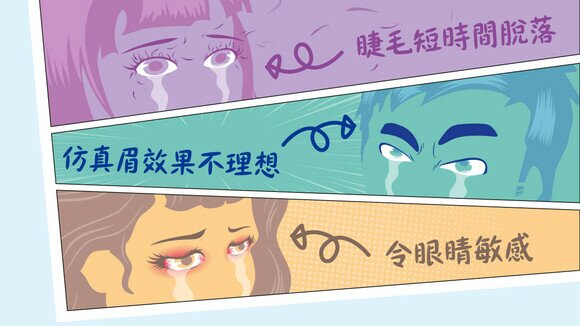Case
Case 1: Choosing imitation eyebrows service upon persuasion but ended up with disappointing results
Mr. Kwok is image-conscious. He intended to purchase a $680 eyebrow microblading service from Beauty Parlour A (“Parlour A”) but was persuaded by the staff to switch to a service that could produce a better effect of imitation eyebrows. Mr. Kwok was shown several photos of other customers who had used the service. Even though the price of imitation eyebrows was higher at $2,520, Mr. Kwok agreed to take out the service as he was satisfied with the effect as seen from the sample photos. However, after the service, his eyebrows turned out to look very unnatural. They were overly dark and thick, and did not have a well-defined shape, and looked as if were drawn with a marker pen.
The staff explained that it might take some time to get used to the new look, and persuaded Mr. Kwok into purchasing a correction fluid for $680, which could make the eyebrows look more natural and longer-lasting. Mr. Kwok did not want to spend more money, but due to the unsatisfactory effect, he agreed to try it out. Later, he learned from a friend who had similar service that imitation eyebrows should not be coloured to such an exaggerated extent and that his eyebrows also looked asymmetrical. Mr. Kwok was frustrated and his self-confidence was undermined. He therefore lodged a complaint with the Council and asked for a refund from Parlour A due to disappointing results.
Follow up actions:
After the Council’s conciliation, Parlour A declined to refund for the correction fluid as it had already been opened but offered Mr. Kwok to swap for another treatment or product of equivalent value, and he was also advised to return to the parlour for another eyebrow makeover. But Mr. Kwok refused as he had already lost faith in Parlour A and would consider taking civil action to seek redress.
Case 2: Eyelash implants fell off after a short time
Miss Ho was enticed by a social media advertisement of Beauty Parlour B (“Parlour B”) that promoted Japanese-style eyelash implants with the latest technique that promised a natural effect. The price for a trial course for new customers was advertised at $298. Miss Ho went to the parlour but was persuaded by the staff to add $150 to buy a better-quality and hypoallergenic glue. The staff further explained that the implants would only last for 1 – 1.5 months and therefore she should use the new customer promotion price of $1,000 to book 3 more sessions in advance. Miss Ho agreed to the deal and paid a total of $1,448 in cash. After the service, she followed the instructions and avoided rubbing her eyes forcefully when washing her face but the implants began to fall off after only 3 days and her eyelashes looked embarrassingly uneven. Although Parlour B provided “replant” service, there was no real improvement and the implants nearly all fell off after 5 days.
Parlour B refused to provide further replant service. Being disappointed, Miss Ho asked the parlour to remove the remaining implants and refund the 3 additional sessions but the parlour agreed only to remove the implants. Miss Ho lodged a complaint with the Council and asked for a refund of $1,000. She queried the veracity of the advertisement which claimed that the implants would last for approximately 1 – 1.5 months. She was further dissatisfied that the beautician had cut short her real eyelashes while removing the implants.
Follow up actions:
Parlour B stressed that the effect of eyelash implants varied from person to person, so they refused to provide a refund but only agreed to let the complainant swap to other beauty services of equivalent value. Miss Ho had not come back for further actions.
Case 3: Eyeliner tattoo causing allergic reaction
Ms. Cheung purchased an eyeliner tattoo service from Beauty Parlour C (“Parlour C”) for a total price of $1,850 which include a colouring and a re-colouring sessions, as well as $50 worth of medical cream. Upon returning home after the service, her eyes became itchy and swollen. She went to see a doctor the next day and was told that the condition might have been caused by the ink and was prescribed with antibiotics and steroid. She complained to the staff of Parlour C who initially promised to a refund but later retracted saying that this would need approval from the company.
One week later, the manager of Parlour C contacted Ms. Cheung and said that they never had any complaint from other customers and that her condition might have been caused by her own sensitive skin. Parlour C suggested that the remaining re-colouring session be changed to an eyebrow tattoo or other service. However, Ms. Cheung declined as she did not want another adverse allergic reaction. When she lodged the complaint with the Council, she mentioned that Parlour C did not issue any official receipt. She paid cash for the service and only had communication records as transaction proof. Despite a severe allergic reaction, Ms. Cheung was prepared to forgo compensation for her medical expenses, but only asked for a refund of 1/2 of the price she paid (i.e. $900) given that she had not used the re-colouring service.
Follow up actions:
Parlour C explained that the price for the eyeliner tattoo service came in a package and could not be distinctively separated into 2 sessions (colouring / re-colouring). As the colouring service had been rendered, Ms. Cheung would be entitled to a free re-colourng service. Parlour C reiterated that no refund would be provided for conditions caused by a customer’s own sensitive skin, but offered Ms. Cheung to swap the re-colouring service for another facial treatment. The Council advised Ms. Cheung to pursue her case further through the Small Claims Tribunal.



